Is this just fantasy: Inside a high-stakes Vegas roto draft with the legends
LAS VEGAS - My attempt to squeeze in a bit more sleep was futile. I reached over and picked up my phone from the bedside table at The LINQ hotel in Las Vegas, and saw it was a little after 5 a.m.
Physically, I was weary from spending the previous week in Arizona covering spring training. I enjoy visiting spring camps - it's the best time of year to cover baseball, with access to players in relaxed environments. But I still hadn't adapted to Pacific time, and I never sleep as well in hotels.
Mentally, though, I was wired. Nerves and anticipation had been simmering the last week, and now they reached a boil. It was draft day.
In a few hours, I'd be making my way to The Mirage to select my team in what's regarded as the richest and most competitive fantasy baseball league: the National Fantasy Baseball Championship (NFBC) Main Event.
This was my fourth year playing, and I felt pressure to be better. I don't want to continue to serve as ballast for the prize pool.
Out of roughly 800 teams to play on average the last three years, I finished 348th (2021), 203rd (2022), and 527th last year - slightly above the 50th percentile. But the 50th percentile doesn't pay.
There are always some draft-day nerves because I don't want to screw up this expensive effort. The entry fee is $1,750, a hefty sum for many of us.
"That's the definition of disposable income," a friend of mine said when I explained why I was in Vegas. "You are literally disposing of it."
My wife isn't in love with my involvement, either.
There are two components to the Main Event: Each entry competes in a 15-team league with a $7,000 prize to the winner, and then there's what everyone is truly dreaming of, the overall competition, in which the first-place winner takes home $200,000. Other top finishers are paid, too, but that's the headline number. There are a record 855 participants in the Main Event this year.
There are always some predraft nerves for me, but there was added anxiety this morning, the kind I associate with a job interview or the first day of school. This was the first time I would be drafting a Main Event live, the first time I'd be drafting a fantasy team of any sort live in years.
I began participating in nationwide fantasy baseball contests in my teens with my dad. We saw an ad for the Diamond Challenge in a magazine that read something like, "Do you want to be a GM?" and I was immediately intrigued. At that time, transactions had to be called into a 1-800 number each Sunday evening, and it cost $2.50 to make a lineup change, and $10 for a player add.
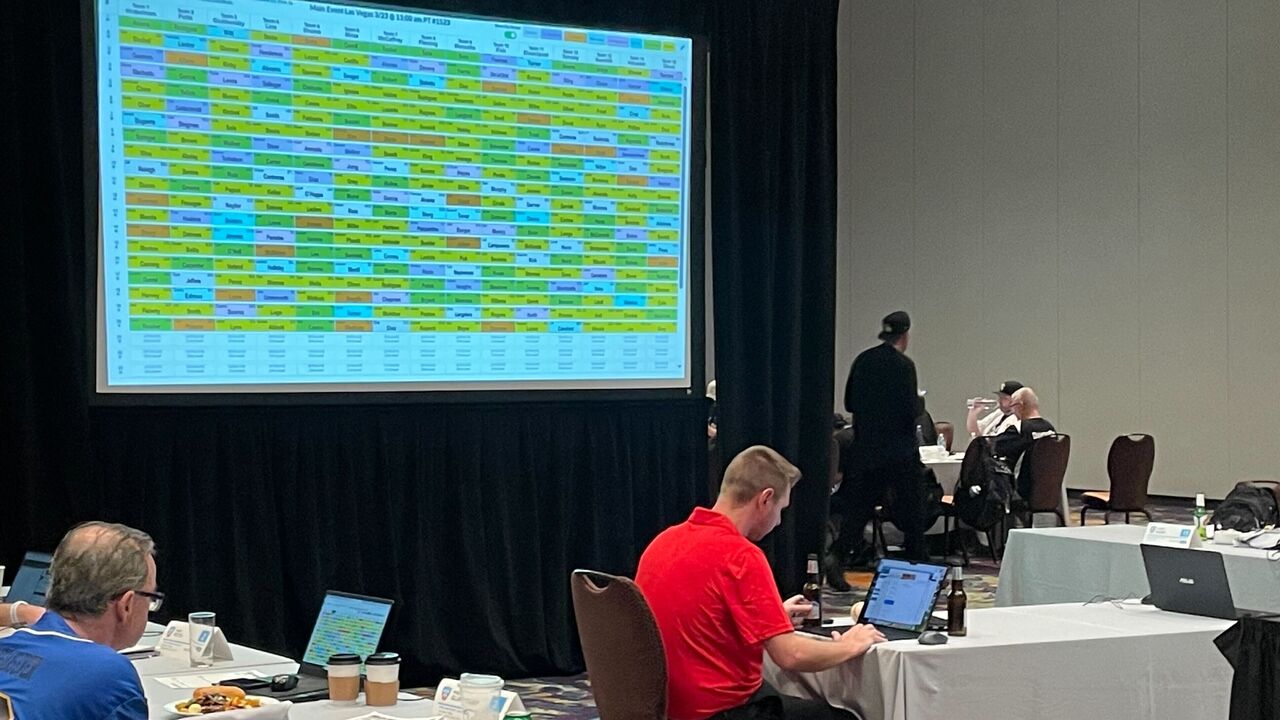
I played on my own in the Diamond Challenge after college when the game migrated online. I finished fourth overall in 2008 and won $5,000. But mostly I lost, and I stopped playing in large contests. It was only during the 2020 pandemic year, perhaps a decade after I originally stopped, when I learned of the NFBC, which had absorbed the Diamond Challenge. After a year of playing in a lower-stakes league and listening to fantasy podcasters talk about the Main Event, I decided to play. And here I was, in Vegas.
I asked some veteran players what live versus online was like and the consensus was that it's a great experience but more distracting. There'd be eight drafts going on simultaneously in the conference room, everyone can hear picks from other leagues, and team owners around you could be distracting, too. I was also going to be making a first impression in a room full of fantasy legends and I didn't want to make a fool of myself with panicked picks as the clock neared zero.
After scrolling through X looking for last-minute injury updates and roster news, I made my way to a nearby Starbucks for a jolt of caffeine and to eat something to settle my anxious stomach. It was almost time.
'The League of Death'
About an hour before the draft, I made my way to The Mirage. I passed through the din of the casino floor, down a corridor of restaurants and shops, and eventually reached the convention center at the complex's rear.

With a half hour before the start, I entered a giant, library-quiet ballroom where the draft was taking place. Other participants were only beginning to file in. The space seemed large enough to hold an indoor football field.
The league to which I was assigned was situated in the back right corner. There were two open bars. I stuck with Diet Coke, thinking it would be better for my decision-making.
Each of the eight leagues had tables arranged in a U shape facing a large screen showing the draft board. The owners' seats were assigned by draft order. I was in the 13th draft position, and my seat was designated with a name placard.
As I set up my computer, NFBC staffer Geoffrey Stein approached to greet me. He'd be entering our picks into the draft software and announcing them.
"They're calling this 'The League of Death,'" he said. I laughed in part because it was hilarious and also because it was true.
Teams are assigned to leagues randomly but my League of Death included five of NFBC's top 30 all-time money winners. There was Lindy Hinkelman, a two-time Main Event overall winner who ranks fifth all time in NFBC earnings ($586,650). Next to him was Dave Potts, whose earnings rank 11th ($449,262). Potts has also won millions playing daily fantasy baseball.
Scott Fleming, with $418,925 in winnings, ranks 14th. James Tomony, seated to my left with the No. 12 pick, is another Main Event champion who ranks 22nd with $304,675 in earnings. Clark Olson, with the No. 15 pick, ranks 20th at $234,825. There was more than $2 million in career earnings at the table.
My career NFBC earnings: $300.
When I received an email earlier in the week with the draft order, I was shocked. Hinkelman and Potts had the first two picks.
"Those guys don't need any more help," I thought.
In some years, draft position doesn't matter much. If there's a relatively even spread of first-round talent, it's better to be near the middle or back of the pack. This isn't one of those years.

Atlanta Braves star Ronald Acuña Jr. is coming off one of the best seasons ever: a .337 average, 41 homers, 73 steals, 149 runs, and 106 RBIs.
There was a tremendous gap in value between Acuña and the next-ranked player.
There was a sizable valuation difference between Spencer Strider and the next-ranked pitcher. Strider's already an outlier in terms of strikeouts and he's added a new curveball. He also plays for MLB's top-projected team, the Braves, meaning he should win a lot of games. He figures to help in four of the five pitching categories: ERA, WHIP, wins, and strikeouts.
There was also a considerable gap after the next tier, which includes Julio Rodríguez, Bobby Witt Jr., Mookie Betts, Corbin Carroll, and Kyle Tucker. They're the rare position players who help in all five offensive categories.
Rotisserie scoring ranks teams in each of the 10 categories, giving 15 points to the leader and one point to the team in last. Teams are ranked on their total points in all 10 categories. It doesn't pay to punt a category like steals to load up elsewhere, which is why five-category players are so valuable. None of them were going to be on the board when my first pick came at 13.
The room got noisier as it filled, and NFBC founder and general manager Greg Ambrosius stepped to a podium up at the front to make some remarks.
He addressed the offseason's crisis: A former NFBC employee was caught making illegal, post-deadline lineup changes for a team owner in one of the football contest leagues - a major issue for a community built on trust. Still, most of us returned. We believed it was likely an outlier occurrence.
Ambrosius then welcomed NFBC Hall of Famers to the front. Several of my league mates made their way forward.
Then Ambrosius concluded: "Today is a celebration of 21 years of the NFBC. I wish you all good luck today. Team 1, here we go everyone. Team 1, you are on the clock. Good luck everyone."
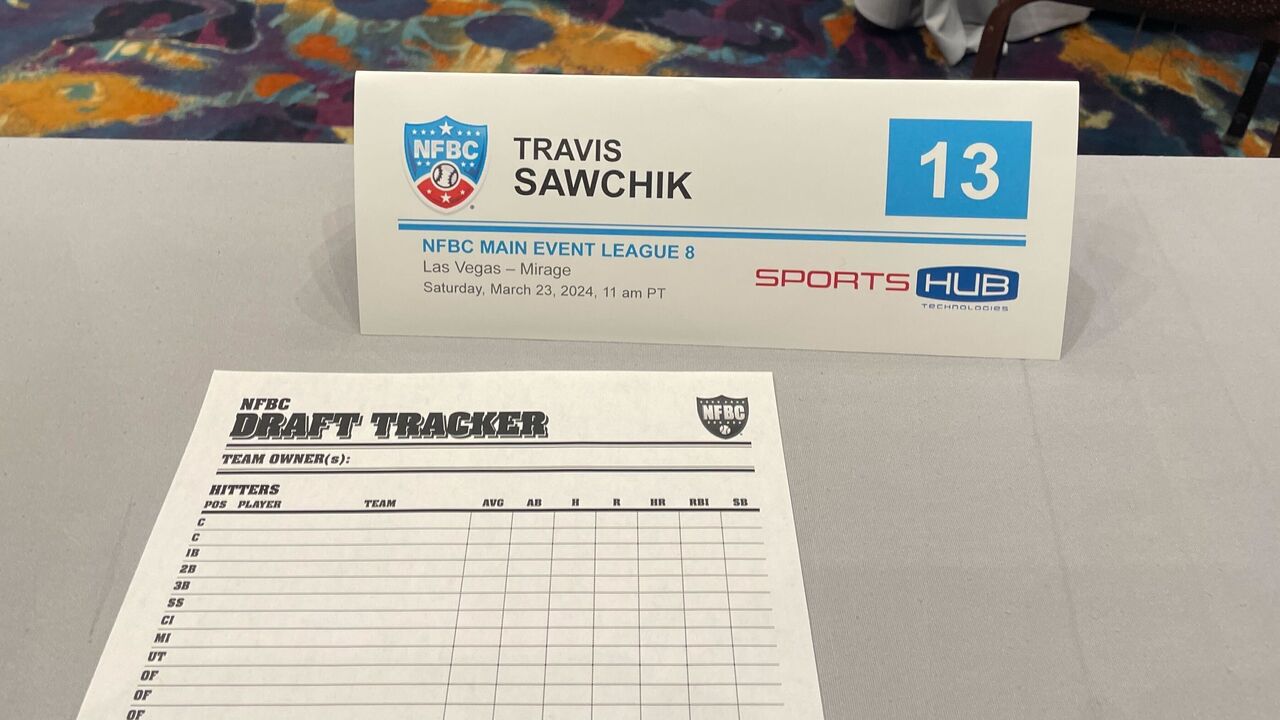
The giant room started buzzing. In our corner, Stein sprung into action. "We got everyone here. Are we good to go?" he asked. Heads nodded.
Hinkelman, sporting a black Adley Rutschman T-shirt (a signal or false flag?), took Acuña Jr. Potts took Rodríguez next.
I quickly understood what others said about being distracted by other drafts. From a nearby table I heard: "Team 6, Fernando Tatis."
Stein began moving around the table, announcing names spoken to him. He entered them onto the giant draft board via his iPad. Players were color coded by position.
I planned to take Yordan Alvarez.

While he wouldn't help with steals, he's one of the game's most talented hitters and would help in the other four categories. He's one of the few players who's a threat to hit 50 home runs, and home runs correlate to runs and RBIs. He should be available, according to the average draft position (ADP) of the Main Event online drafts staged to that point. The players at the end of the first round were still tremendous talents but had holes that could be poked in their resumes.
Stein reached Tomony, an amiable, silver-haired psychologist from Madison, Wisconsin.
"Jim?" Stein asked.
"I'm gonna go with Yordan Alvarez," Tomony said.
I'd been sniped on my first live selection.
Stein took another step forward.
"Travis?"
I was on the clock in The League of Death.
Choices
I started my process of creating a rankings list in early January by aggregating four of the public projection systems at FanGraphs. This forms the base. I don't think I can build a better projection model from scratch. But many folks in the draft room are also using them, so you need to look for valuation edges.
I then add my own insights, factoring in things that I think matter and testing their impact on fantasy categories. Underlying skills like exit velocity, maximum exit velocity, pulled balls hit in the air, sprint speed, and swing decisions are among skills weighted in my rankings.
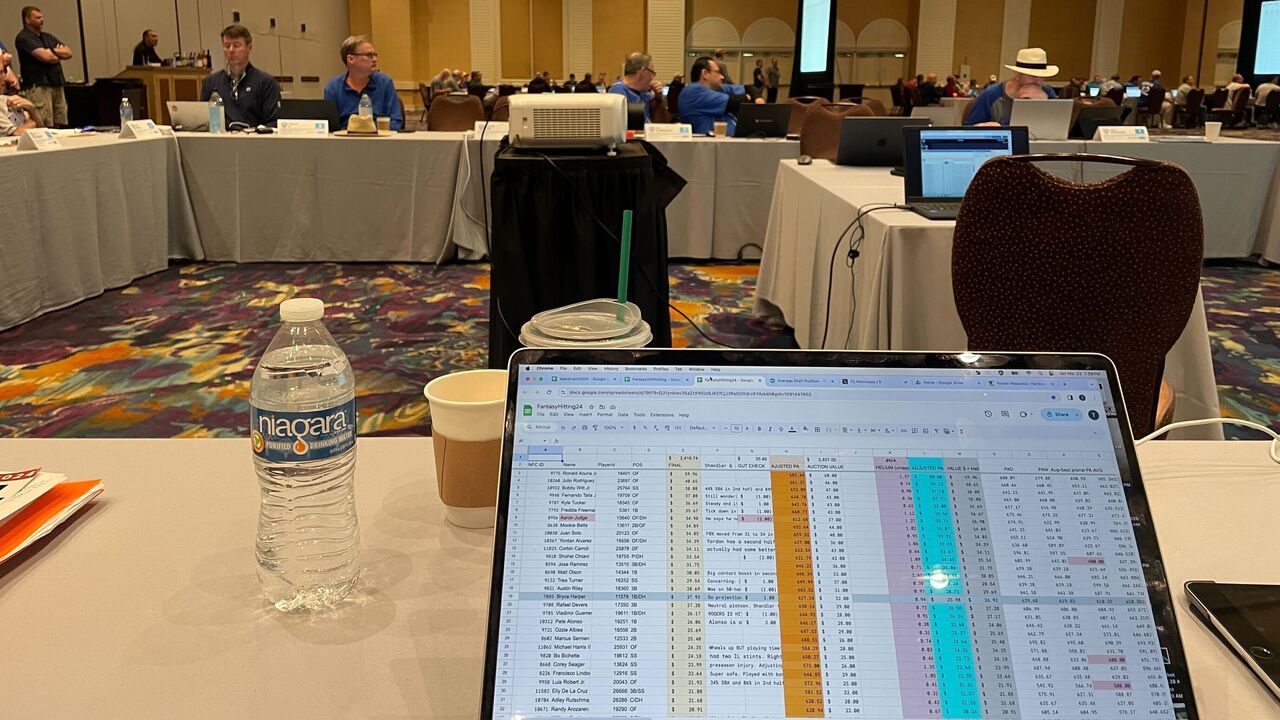
I also read as much as I can about players from media reports, and this year I read every player blurb in Ron Shandler's "Baseball Forecaster." I make notes and may bump up a player modestly on a hunch. It's some art, some science.
When spring training opens, there's a constant stream of new information we must absorb, too. For instance, Shane Bieber's fastball velocity was up 3 mph in his early spring starts after it was revealed he worked at Driveline Baseball. His ADP rose by 50 spots.
But each year I find there's the question of whether or not I'll trust my actual rankings when on the clock.
In past drafts, there were many times where I looked at the top player on my board and didn't take him despite all the hours spent preparing.
How do you weigh gut instinct versus the spreadsheet? It's a dilemma in real baseball and fantasy.
Even the best active fantasy player in the world, Phil Dussault (No. 2 in all-time NFBC earnings), deviated from his process on certain selections on draft day during his best season in 2021.
Dussault's nicknamed "The Robot" for his adherence to a data-based approach that works extraordinarily well. But instinct took the Montreal resident away from his rankings: He trusted his gut and was rewarded with a late-round gem of Carlos Rodón in the 25th round, which helped him with the 2021 Main Event.
Now I was on the clock after being sniped. It only added to my ambivalence.
The projection systems loved Aaron Judge, whose 2022 season was nearly as dominant as Acuña's 2023. I liked Judge, too, but didn't love his injury history; he was limited to 106 games last season.
The night before the draft, I was invited to a dinner hosted by Vlad Sedler, an excellent player and content creator. A number of us were situated at a long table at Lavo, an Italian restaurant at the Venetian Resort.
As folks broke off into separate conversations, I asked Emmett Ruland - 68th in all-time earnings - if he had any advice for a newbie live drafter. He made a case for considering a pitcher, even beyond Strider, in the first round.
One strategy that's become popular in recent years is what's known as "pocket aces," where you draft two starting pitchers within the first three rounds. Ruland was doing that before it was cool.
Traditionally, hitters dominate the first two rounds - they're less risky from a health perspective - but the math in favoring pitchers is clear. There are 14 starting position player spots in a weekly NFBC lineup versus nine pitcher spots. An ace pitcher accounts for a greater share of playing volume than a top hitter.
We also got to talking about a story I wrote last summer about MRIs in sports, to understand why so many injuries are misdiagnosed even with imaging. I learned Ruland is an imaging tech, and he works with a variety of scanners.
One thing I took away from reporting that piece is that I was wrong to be so optimistic about injured players, or players with injury history, entering a season.
Last year I took Jacob deGrom in the first round. Whoops. I took Triston McKenzie in the 27th round thinking his shoulder strain, which occurred in the spring, wouldn't hold him out too long. That didn't work either. He returned from one injury but picked up a new one in his right elbow (one injury can create a weakness that leads to another). I also held on to Mason Miller, an expensive free-agent pickup, after his initial MRI showed no structural damage. A second round of imaging showed a slight elbow tear.
I vowed to not take on injury risk this year - at least not in the top half of the draft.
But if that was my plan, how could I justify taking Judge? He's coming off a toe injury he says will require maintenance, and had some abdominal tightness this spring. He's missed a lot of time in his career. But he's so good when he's healthy.
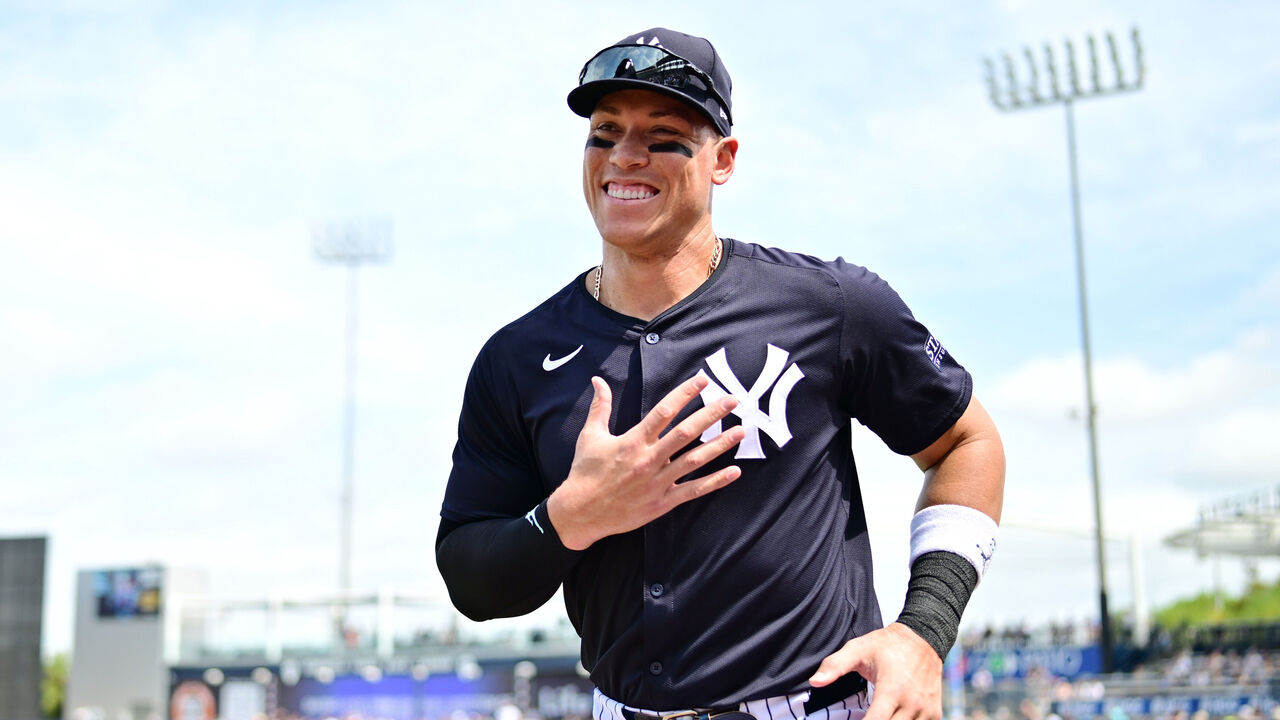
If Judge gives a team 600 plate appearances, he could be the No. 1 fantasy player.
He was ranked as my fifth-best player. But was he too risky? Should I take a pitcher instead?
The 60-second clock was ticking on my most important draft pick of the year.
With Stein hovering over me, I trusted my sheet, my preparation.
"I'll take Judge."
Shopping spree
If you've never drafted a rotisserie team on the clock, I'd liken it to the game show "Supermarket Sweep," where contestants try to maximize the value of what they fit in their grocery cart while racing against time. To do well, you have to know where the pockets of value are in the aisles and how to most efficiently plot a course to reach as many as possible.
In rotisserie baseball, you aren't just filling 23 starting lineup positions and a seven-man bench. You have to think strategically about how to address the 10 scoring categories.
In my preparation, I created a general outline of how I thought I may want to attack the draft pool. I also wrote reminders to myself, hoping to hammer them into my subconsciousness.
"Be balanced," one of those notes said.
Why is balance important? In the midst of the draft, it's much easier to pounce on best values if your roster is balanced throughout and you don't have to address neglected categories like steals and saves on the fly.
As Stein quickly pivoted back for my second-round pick, 18th overall, I again took the highest-ranked player on my list: Braves first baseman Matt Olson, another slugger who doesn't run.
I then had a few minutes to breathe, as the draft had to work its way around and back again. My early jitters were dissipating.
My next two picks went to my top-ranked pitcher, Logan Webb, and Max Fried.
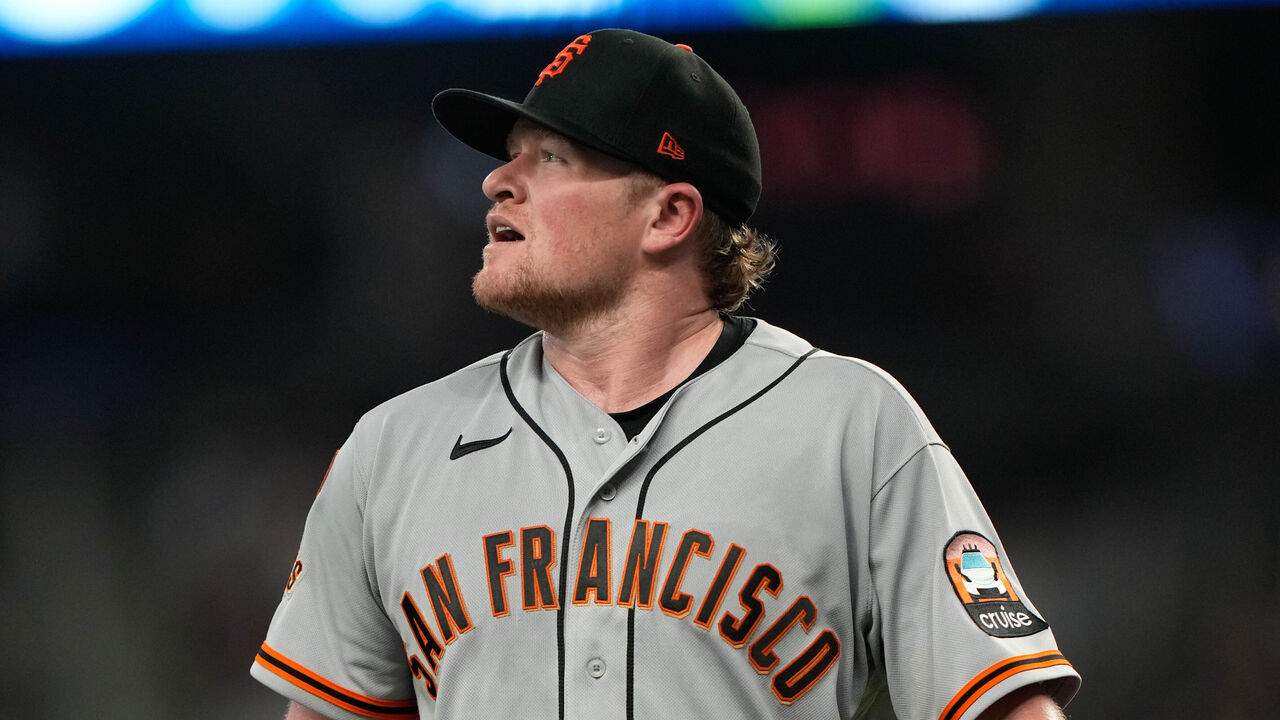
As Stein moved down the line, Tomony turned to me and said, "Max Fried broke my heart last year."
Fried's numbers were excellent but he only made 14 starts because of an elbow strain. So much for avoiding injury risk.
"He'll break my heart two years in a row if he has the year I was expecting last year, this year," Tomony said.
"Every pitcher terrifies me," I replied.
Of course, you can't compete in a Main Event - or most any league - without quality pitching.
In some ways, I achieved early balance: two hitters and two pitchers. They're players who should help in the ratio stats - ERA, WHIP, and batting average - or at least won't hurt me. It can be harder to find players who'll help with those categories later in the draft.
The one glaring unbalance I had so far was in stolen bases. Given the new steals environment, a fantasy team needs a lot of them to compete.
For instance, the 80th-percentile mark for team steals in the Main Event last year was 186. That's 13.3 steals per starting roster spot. I was going to have to play catchup.
In the fifth round, I played my board and took another pitcher, the Twins' Joe Ryan. I was trying to protect ratios and Ryan is a WHIP god with some upside thanks to an expanded pitch arsenal.
But this is when falling out of balance becomes problematic.
In the sixth round, I selected J.T. Realmuto, who I like well enough, but who I'd ranked behind William Contreras in overall catcher value. But I needed steals.
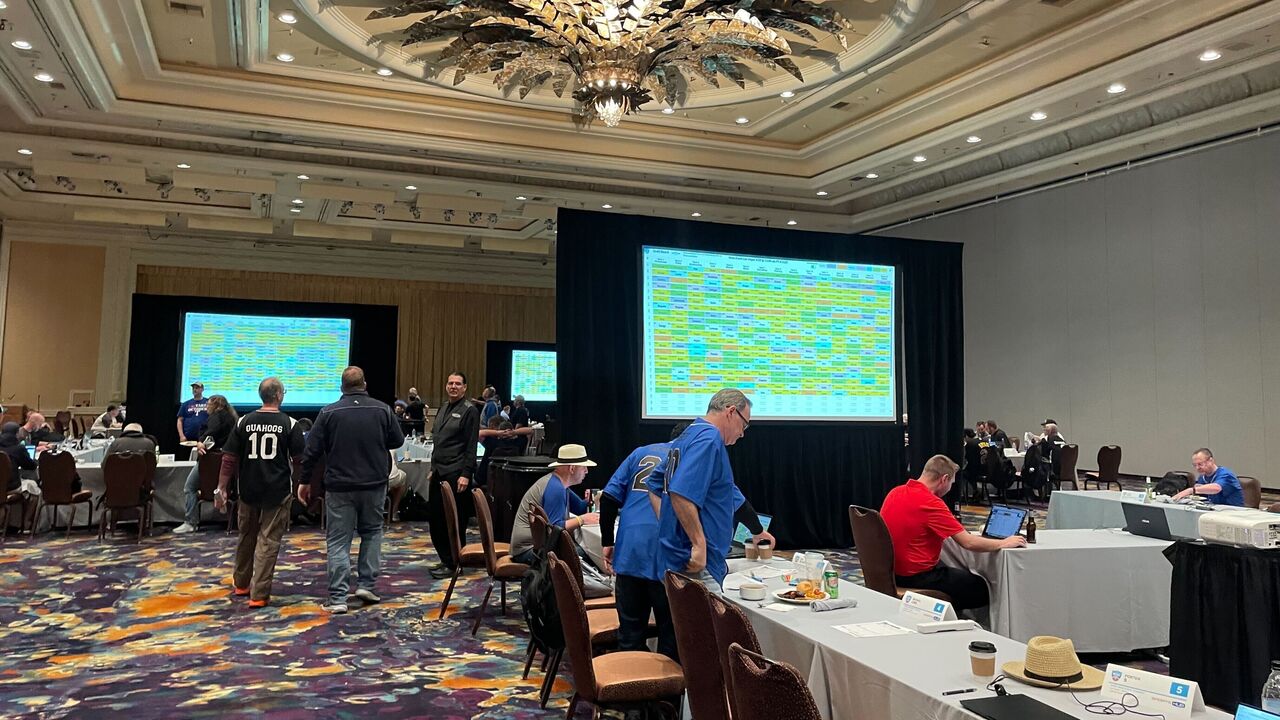
Tomony sniped me again in the seventh round.
We draft in different ways. Many of us bring laptops, some even have multiple screens. Others draft off iPads. Tomony brought only an iPad and several color-coded, handwritten sheets, something like a football coach's play sheet, and made decisions based on them.
He looked at his sheet and broke my heart when he said "Andrés Giménez."
I was eyeing Giménez's balanced production and speed. My comfort waned again and the clock sped up on me.
I then made one of my biggest reaches according to my own valuations and halfheartedly selected Phillies second baseman Bryson Stott, eyeing his stolen bases and secure playing time. There were higher-ranked players on my board like Teoscar Hernández, Christian Encarnacion-Strand, and Bryan Reynolds.
I felt immediate buyer's remorse upon making the pick. But I had to quickly regroup; I couldn't let one mistake bleed into another.
After 10 rounds, I had 67 projected steals for five roster spots - I was back on track at 13.4 steals per spot. But at what cost in terms of value passed upon?
Think unsexy thoughts
I'd typed another reminder in my notes file, hoping the physical act would embed it in my neural pathways: "Be boring."
I hadn't been boring often enough in my previous Main Events. I too often chased the shiny new toy: The exciting rising players of the preseason.
I believed I had to chase upside with every selection in order to beat the field. But as I gained more experience, I learned that's not the way of the fantasy masters. Look at their early-round draft boards and they're boring.
They're generally not chasing breakout picks early. They're trying to make pars in the first half of the draft and then shoot for upside later.
Potts discussed this kind of approach on Sedler's FTN podcast early last season, an episode titled "Bringing Unsexy Back."
When I listened to the episode, my 2023 team was performing well and I'd been as high as fourth overall in the Main Event. I'd taken a decidedly sexy approach that included selecting deGrom and Tatis Jr. in the first two rounds. I thought my way was working, but I was flying too close to the sun. My depth-starved, injury risk-riddled team soon fell apart.
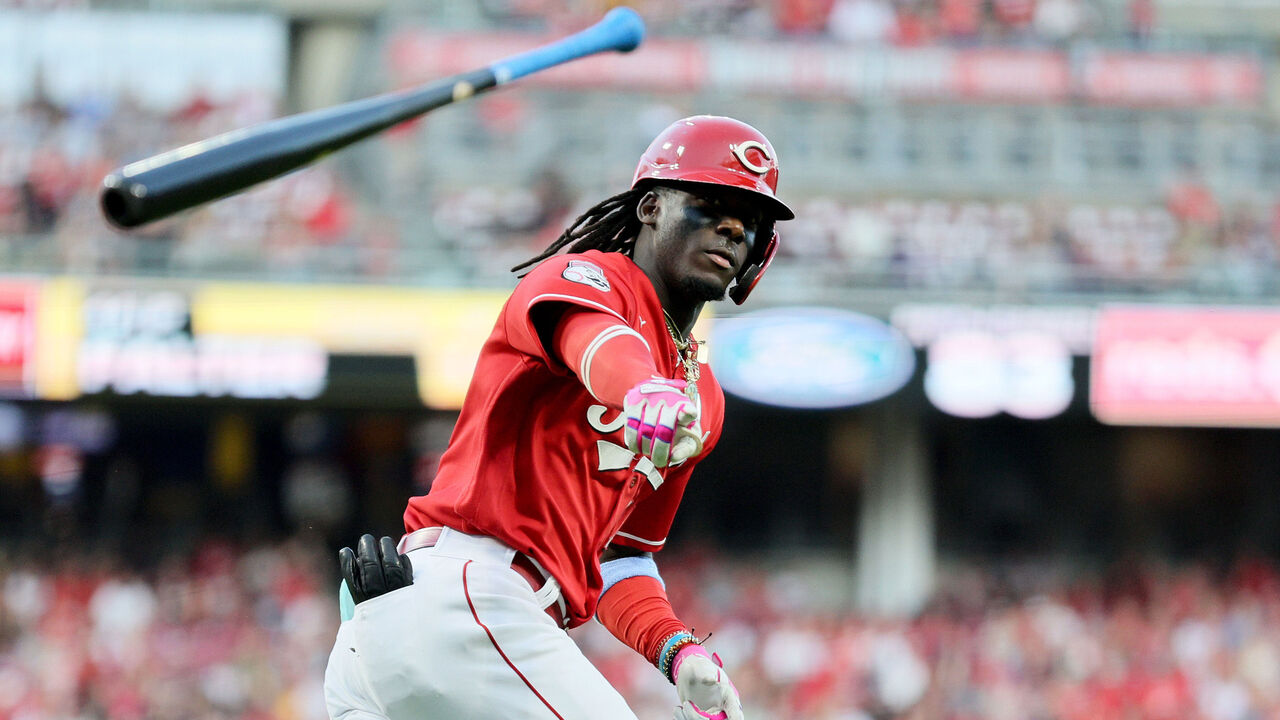
Potts' approach was something like Warren Buffett's value-investing approach: buy quality companies at fair prices. Mine had been a bit more like YOLOing GameStop stock during the pandemic.
Early on in Vegas, I felt FOMO watching an exciting young player like Elly De La Cruz go off the board in the second round. Tarik Skubal went in the third.
For the first half of the draft, I mostly met my goal of building a boring-ish roster. But I took on more injury risk than I would've liked, and also fell out of balance and chased steals. I had mixed feelings as we approached a pause.
The glass is already broken
After the 20th round, there was a lunch break before we embarked on the final 10 rounds, a stretch where uncovering hidden gems can provide exponential returns.
I didn't want to be afraid to take chances here.
I thought about another reminder I'd written to myself: "The glass is already broken." It's from a passage included in the book, "The Daily Stoic: 366 Meditations on Wisdom, Perseverance, and the Art of Living," by authors Ryan Holiday and Stephen Hanselman:
There is a story of a Zen master who had a beautiful prized cup. The master would repeat to himself, 'The glass is already broken.' He enjoyed the cup. He used it. He showed it off to visitors. But in his mind, it was already broken. And so one day, when it actually did break, he simply said, 'Of course.'
I also reminded myself that beginning in the 16th round, there's a greater than 50% chance you'll drop your selection at some point in the season. Those percentages only increase with each pick.
In other words: Don't be afraid to make a mistake. It probably won't matter.
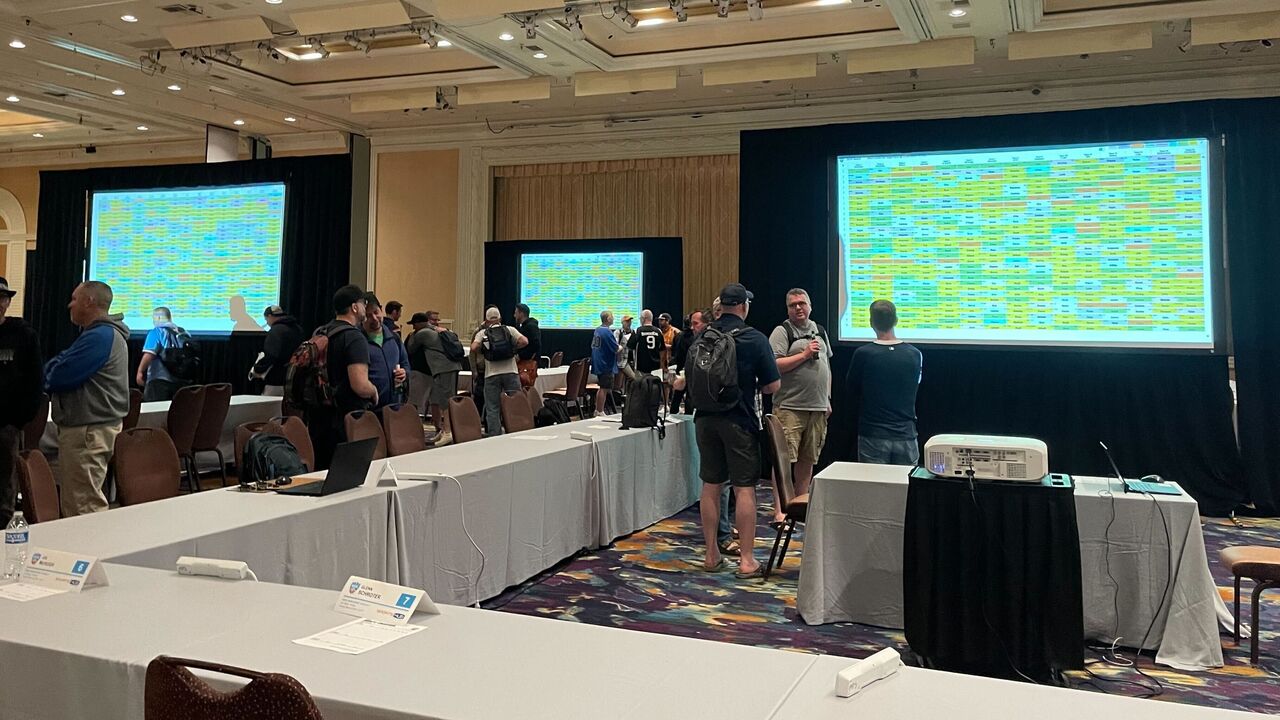
One complication I didn't anticipate was the pace of the groups around us. Other drafts in the room were restarting while we were finishing lunch.
After being able to block out the surrounding noise during most of the draft, now I was intently attuned to all of it. No one wants to have their sleeper targets shouted out publicly in case they've been forgotten by your competitors.
From another table, Jared Jones' name was announced. He's a young power arm for the Pirates who'll open in the rotation.
Max Meyer's name rang out from another table. During the draft, news broke that the former No. 3 overall pick landed a Marlins' rotation spot.
I heard Zack Littell called out, too.
As the 21st round began, I hoped to land the Twins' Max Kepler as my fourth outfielder.
It's tough to find an edge in fantasy baseball, but one area where opportunity lurks is in playing time. Projection systems struggle with assigning innings and plate appearances. If you think you have insights into a player's workload, you may have an edge.
What attracted me to Kepler was that some forecasted him in a platoon this year, but I didn't believe it would happen. He's good enough against left-handed pitching and Minnesota has other lefty hitters more in need of a platoon.
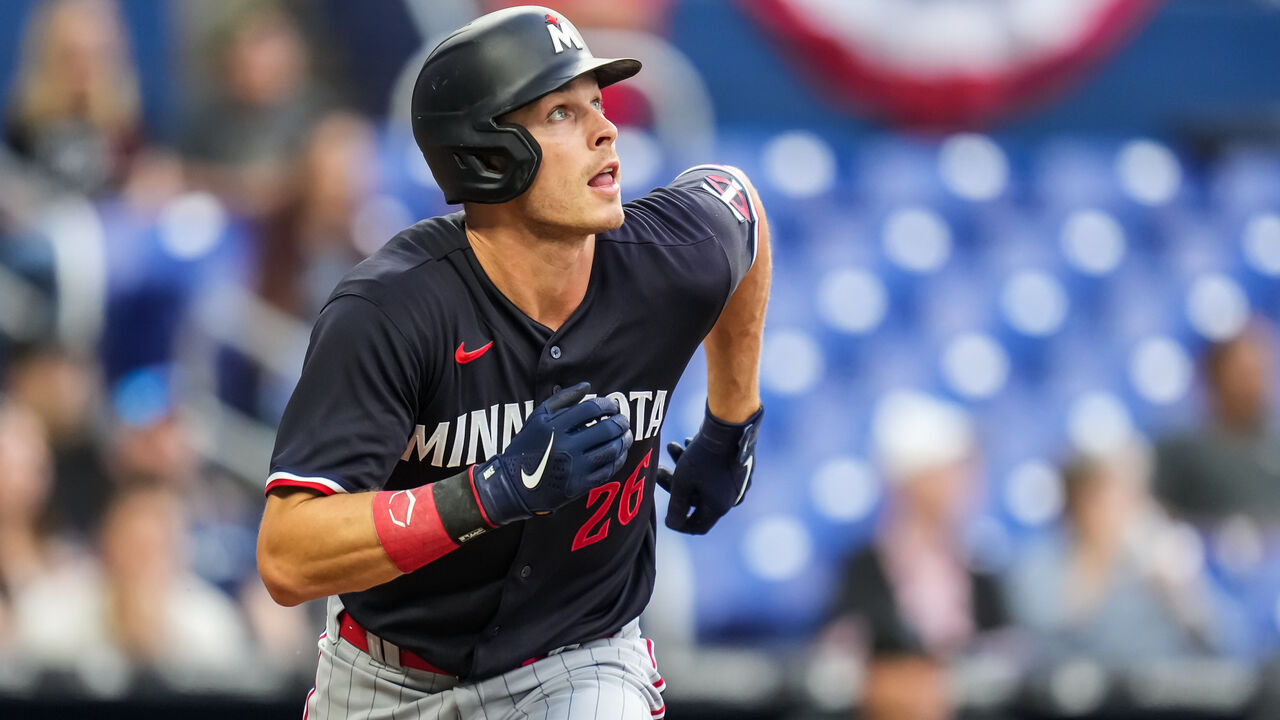
The other thing about Kepler is he made surprisingly good contact with power last year. He was one of only eight hitters with a contact rate of at least 80% and a barrel rate of at least 10%. The others include Acuña Jr., Tucker, Betts, Juan Soto, Freddie Freeman, and Seiya Suzuki.
I was on edge again, fearing Kepler's name would be called as the 21st round advanced.
As Stein approached, Kepler was still available, and I quickly announced his name.
I followed Kepler with a stash player I liked in right-hander Shane Baz, then added promising young pitcher DL Hall, and Boston's Tanner Houck.
I took LaMonte Wade Jr. in the 30th round with my final pick. And with that selection, the draft was over. Exhale.
As the draft wrapped, we assessed our boards with our neighbors. Veteran players mingled with longtime friends and competitors.
Adding an extra and final bit of excitement, FantasyPros and NFBC immediately spit out draft grades for teams based on their projections. I was a bit nervous about seeing my early report card, but was relieved to see grades of 84 and 88 for my team, and projected sixth- and fourth-place finishes. Not bad for The League of Death.
Many of us walked around and studied the completed boards of the other seven drafts, to see which teams looked strong, and where our own selections were made in other leagues. It was like a bizarre art gallery.
Then the hotel staff dimmed the lights and began moving the enormous ceiling-to-floor partition walls on their tracks to cut the room in two for another forthcoming event.
I lingered a bit longer looking at the color-coded boards. These giant draft charts are essentially snapshots in time, our best guesses as of March 23, 2024. Tomony estimated that maybe 60% of success is tied to draft choices, and the other 40% to free-agent pickups and lineup decisions. As important as the draft is, it may not be quite as important as it feels in the moment.
I emerged into the early afternoon sunlight on Las Vegas Boulevard with no idea if my draft would be a success. Most likely, it would not.
But the experience had it all. I felt anxiety, anguish, and elation. I battled FOMO and tried to embrace restraint. I had immediate regrets and felt I won some victories. And it was exhilarating to experience all those emotions in three hours. I may never win much of anything in the Main Event, but I'll be back.
Travis Sawchik is theScore's senior baseball writer.